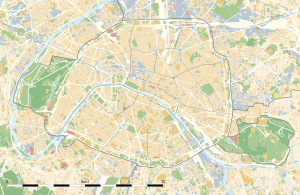Tour de Nesle
| Tour de Nesle | |
|---|---|
| Part of wall of Philippe Auguste | |
| Paris in |
|

Tour de Nesle in January 1608 (detail from
Patineurs sur la Seine en 1608, Carnavalet Museum) |
|
| Coordinates | 48°51′27″N 2°20′14″E / 48.8575°N 2.337222°E |
| Type | Corner tower |
| Height | 25 meters |
| Site information | |
| Condition | Destroyed |
| Site history | |
| Built | circa 1200 |
| Built by | Philippe Auguste |
| Materials | Stone |
| Demolished | 1665 |
| Events | Tour de Nesle Affair |
The Tour de Nesle or Nesle's Tower was a guard tower of the old city wall of Paris on the left (south) bank, constructed at the beginning of the 13th century by Philip II of France and demolished in 1665.
The tower was situated on the left bank of the Seine facing the old castle of the Louvre on the opposite, right bank. Originally known as the Tour Hamelin this was a cylindrical structure of approximately 10 metres in diameter. The height was around 25 metres, with a stair turret reaching higher still. Later on, the tower was incorporated into the Hôtel de Nesle, a medieval mansion. Old engravings show that there was a similar tall tower on the right bank of the Seine adjacent to the Louvre, therefore the towers may have together protected the upstream approach into the city towards the Île de la Cité. Records show this other tower was at one time called the Tour de la Conférence and Tour du Coin.
In 1308, Philip IV bought the tower from Amaury de Nesle. In 1319, Philip V donated the building to his Queen Jeanne de Bourgogne and she in her will, left it for the College of Burgundy which she founded for the University of Paris. Demolished in 1665, mansion and tower became the place of the Collège des Quatre-Nations (later occupied by the Institut de France) with the Bibliothèque Mazarine.
In the 19th century, Alexandre Dumas wrote the celebrated romance La Tour de Nesle, where he made the place a theatre of orgy and the place of murder of the Queen of France at the beginning of the 14th century, (likely Margaret of Burgundy). His story is based on the fifteenth century legend known as the Tour de Nesle Affair (), centering on actual events that took place in 1314 where the daughters-in-law of Philip IV were accused of adultery, and their alleged lovers tortured, flayed and executed.
...
Wikipedia

